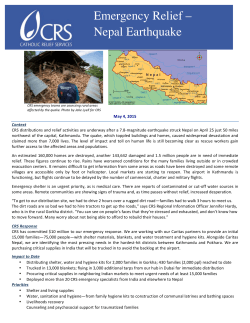
CHILDREN ROUGH SLEEPERS : THE NEED FOR RESEARCH Professor Kate Moss
CHILDREN ROUGH SLEEPERS : THE NEED FOR RESEARCH Professor Kate Moss Professor of Criminal Justice University of Wolverhampton The Children Rough Sleepers Project is a pioneering € 1.25 M research project financed by the EU Daphne Programme. Its objective is to conduct Europewide studies into the phenomenon of runaway and homeless minors who sleep rough, as it is known that the numbers of these children have risen markedly over the last 20 years and that existing preventative protection measures are not benefiting them. Led by the University of Wolverhampton and in collaboration with 10 European partners, the focus of these investigations is upon vulnerable children who, besides being often victims of sexual exploitation or abuse, can also be perpetrators of crime in order to survive on the streets in urban centres across Europe. The researchers will interview children from the streets. Concomitantly, and with the aim of sharing their findings, they will also consult closely with professionals and organizations such as social workers, health and education staff, police as well as victim support services working in the field. Moreover, in order to assess the similarities and differences amongst children rough sleepers (CRS) throughout Europe, the project necessarily treats of a joint study which includes partners from the UK, the Czech Republic, Hungary, Italy, the Netherlands, Poland, Portugal, Romania, Slovenia and Spain. It is with this common objective in view that the team of experts is researching the scale of the problem as well as evaluating the efficacy, or the lack thereof, of those services which currently address CRS-related issues. Included among its activities is the development of an online virtual network tailored to support those organizations and public authorities which work with CRS, whether hands-on in the form of NGOs or by way of policy development, as well as to generate synergies for their future cooperation. The team will also organize workshops and conferences designed to stimulate knowledge transfer and encourage the sharing of best practices. To this end they have created a website, are presently compiling ‘what works’ guides and publishing monthly online newsletters as well as structuring training workshops destined to around 2,100 key professionals, children, young people and community members. A fundamental point underpinning the urgency of this research includes the sheer scope of the issue of missing, runaway and homeless children - a problem both extensive and ever increasing. It seeks to highlight the lack of basic systems in countries to adequately respond to emerging CRS needs and underscores the urgency to develop and update a Europewide network encompassing the widest possible membership. Furthermore, it points to the unsatisfactory situation today of insufficient multistakeholder collaboration and guidance. Stakeholders fail to share their information, all operating within different workplace cultures and as such lacking a single set of guidelines which render decisions concerning children uniform. A direct consequence therefore is limited knowledge of specialized support services in the EU as well as gaps in service provision to missing and homeless minors. All this spells significant gaps in research, in understanding as well as in specialist support services and procedures respecting CRS. Ongoing research also strives to identify better ways to support families. It begs clarification on the criteria by which certain disappearances are reported to the police and on how related services are managed. Added studies are required to ascertain whether, and to determine how, scenarios are constructed by different stakeholders, the scenario typologies adopted to explain different types of homelessness/disappearances, how these affect investigative responses and how they help in developing search strategies. More in-depth examination is also required to understand the responsibility of statutory, voluntary and private sector care providers. This demonstrates our preference for a multi-stakeholder risk assessment methods and procedures, including the exchange of information among all players. Many of the EU member states share these problems, which have of late increased as a direct result of austerity measures. For this reason, the 10 countries involved in the project will be working together to identify EU best practices, appreciate target group priorities as well as improve services hitherto developed to meet the needs of this vulnerable group and so to achieve its empowerment through knowledge transfer, network development and awareness raising.
© Copyright 2025





















